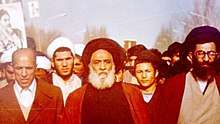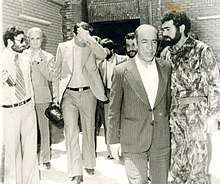Taher Ahmadzadeh
Taher Ahmadzadeh Heravi (Persian: طاهر احمدزاده هروی; 1921 – 30 November 2017) was an Iranian nationalist-religious political activist who held office as the first governor of Khorasan Province after the Iranian Revolution.[1]
Taher Ahmadzadeh | |
|---|---|
 From left Taher Ahmadzade, Kazem Akhavan Mar'ashi, Ali Khamenei in 1979 Iranian Revolution | |
| Governor of Khorasan Province | |
| In office February 1979 – September 1980 | |
| Prime Minister | Mehdi Bazargan |
| Preceded by | Sadegh Amir-Azizi |
| Succeeded by | Hassan Ghafourifard |
| Personal details | |
| Born | 1921[1] Mashhad, Iran[1] |
| Died | 30 November 2017 (aged 95–96) Mashhad, Iran |
| Nationality | Iranian |
| Political party | Council of Nationalist-Religious Activists of Iran (2000–2017)[2] Freedom Movement of Iran (1961–1980s) National Front (1950s–1961) |
| Nickname(s) | Agha Taher (among friends)[3] |

Early life and education
Ahmadzadeh was of Afghan descent.[4] His father was a wealthy Shia from the city of Herat, Afghanistan who migrated to Iran.[3] Ahmadzadeh studied secondary education and was considered a small landowner in his birthplace Mashhad.[1]
Career
Ahmadzadeh was an active opposition to Pahlavi dynasty since the early 1950s and hailed as the "symbol of heroic resistance against SAVAK", spending 10 years in prison under the regime.[5] Considered a well-known nationalist and a prominent leader in Mashhad,[6] he co-founded a Mossadeghist and religious organization called the 'Center for the Publication of Islamic Truths' along with Mohammad-Taqi Shariati, father of Ali Shariati.[7] He joined National Front's 'National Resistance Movement' in Khorasan after the 1953 coup d'état and served as a member of central committee of its provincial branch, though not affiliated with any particular political party.[8] Working closely with Mehdi Bazargan for almost four decades, he also helped him found the Freedom Movement of Iran.[5]
After Iranian Revolution in 1979, Bazargan nominated him as the governor of Khorasan Province. Ahmadzadeh initially rejected the appointment, on the grounds that Ruhollah Khomeini has installed Abbas Vaez-Tabasi as the costudian of Astan Quds Razavi and he should maintain the former position as well. He was ousted soon after resignation of Bazargan.[4] According to Ervand Abrahamian, he was tagged "liberal"[5] and a "sympathizer of the Mojahedin"[9] at the time.
In June 1981, he started to openly criticizing the clergy for "monopolizing power".[5] Sobsequently, Ahmadzadeh was imprisoned in Evin Prison and in 1983 he was forced to confess in a televised program called "roundtable discussions". He was released four years later.[5] Ahmadzadeh was detained again in 2000, when he was 80.[10]
Personal life
His sons Masoud and Majid, as well as his daughter Mastureh were among leading members of the Organization of Iranian People's Fedai Guerrillas. His youngest son, Mojtaba, was a sympathizer of the People's Mujahedin of Iran and was executed during 1988 executions of Iranian political prisoners.[11]
References
- Mehrzad Boroujerdi (1996). Iranian Intellectuals and the West: The Tormented Triumph of Nativism. Syracuse University Press. p. 186. ISBN 978-0-8156-0433-4.
- Muhammad Sahimi (13 July 2009), "Hunger Strike at UN", Tehran Bureau, PBS, retrieved 1 December 2017
- Ali Rahnema (2000). An Islamic Utopian: A Political Biography of Ali Shariati. I.B.Tauris. p. 18. ISBN 1860645526.
- Adelkhah, Fariba (2015). The Thousand and One Borders of Iran: Travel and Identity. Iranian Studies. 27. Routledge. p. 168. ISBN 1317418972.
- Abrahamian, Ervand (1999). Tortured Confessions: Prisons and Public Recantations in Modern Iran. University of California Press. p. 155. ISBN 9780520216235.
- Vahabzadeh, Peyman (2010). Guerrilla Odyssey: Modernization, Secularism, Democracy, and the Fadai Period of National Liberation In Iran, 1971-1979. Syracuse University Press. p. 22.
- Ali Rahnema (2000). An Islamic Utopian: A Political Biography of Ali Shariati. I.B.Tauris. p. 18. ISBN 1860645526.
- Ali Rahnema (2000). An Islamic Utopian: A Political Biography of Ali Shariati. I.B.Tauris. pp. 21, 55. ISBN 1860645526.
- Ervand Abrahamian (1989), Radical Islam: the Iranian Mojahedin, Society and culture in the modern Middle East, 3, I.B.Tauris, p. 188, ISBN 9781850430773
- "Suppression of the Religious - Nationalist Alliance", Human Rights Watch, 2001, retrieved 1 December 2017
- Fariba Amini (23 October 2006), Cries from the heart: History of torture and abuse of women in Iranian prisons, Payvand, retrieved 1 December 2017